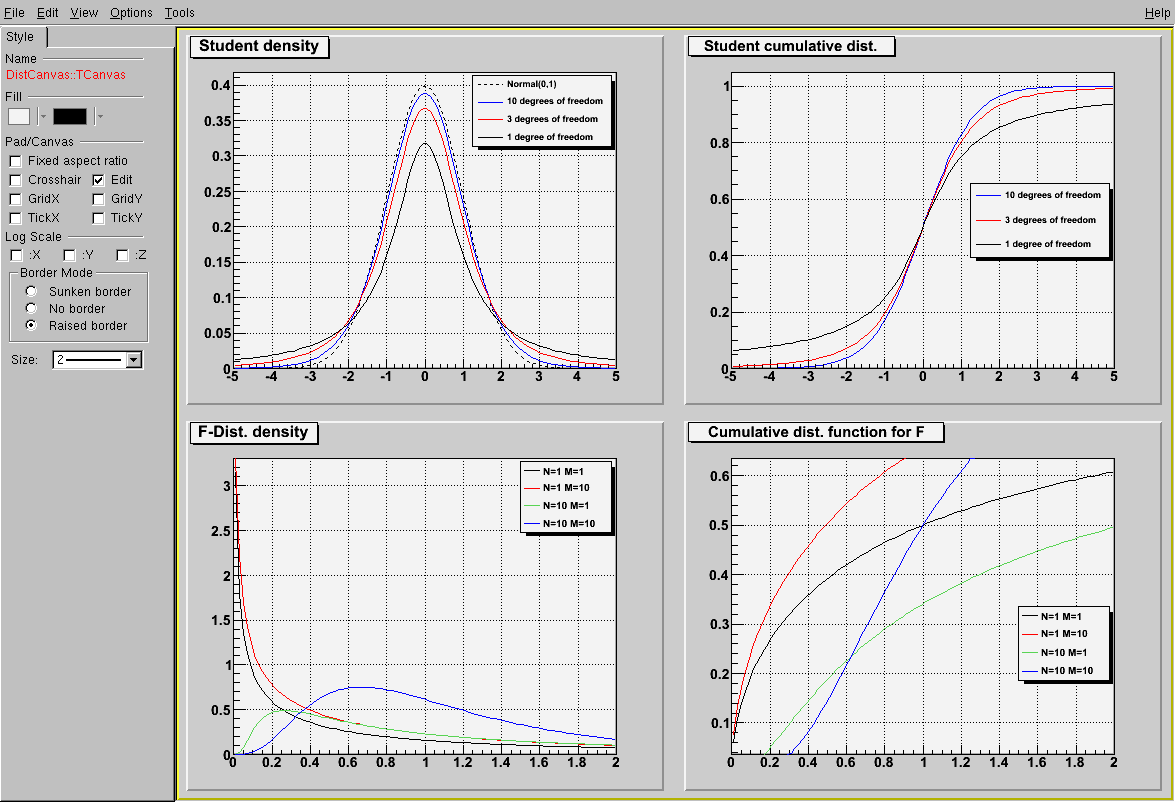
| mathLaplace.C: Test the TMath::LaplaceDist and TMath::LaplaceDistI functions | Math tutorials | mathcoreCDF.C: Example describing how to use the different cumulative distribution functions in ROOT. |
mathStudent.C: tutorial illustrating the use of the Student and F distributions
// tutorial illustrating the use of the Student and F distributions // author: Anna Kreshuk #include "TMath.h" #include "TF1.h" #include "TCanvas.h" #include <Riostream.h> #include "TLegend.h" #include "TLegendEntry.h" void mathStudent() { //drawing the set of student density functions //normal(0, 1) density drawn for comparison TCanvas *DistCanvas = new TCanvas("DistCanvas", "Distribution graphs", 10, 10, 1000, 800); DistCanvas->SetFillColor(17); DistCanvas->Divide(2, 2); DistCanvas->cd(1); gPad->SetGrid(); gPad->SetFrameFillColor(19); TLegend *leg = new TLegend(0.6, 0.7, 0.89, 0.89); TF1* fgaus = new TF1("gaus", "TMath::Gaus(x, [0], [1], [2])", -5, 5); fgaus->SetTitle("Student density"); fgaus->SetLineStyle(2); fgaus->SetLineWidth(1); fgaus->SetParameters(0, 1, kTRUE); leg->AddEntry(fgaus->DrawCopy(), "Normal(0,1)", "l"); TF1* student = new TF1("student", "TMath::Student(x,[0])", -5, 5); //student->SetTitle("Student density"); student->SetLineWidth(1); student->SetParameter(0, 10); student->SetLineColor(4); leg->AddEntry(student->DrawCopy("lsame"), "10 degrees of freedom", "l"); student->SetParameter(0, 3); student->SetLineColor(2); leg->AddEntry(student->DrawCopy("lsame"), "3 degrees of freedom", "l"); student->SetParameter(0, 1); student->SetLineColor(1); leg->AddEntry(student->DrawCopy("lsame"), "1 degree of freedom", "l"); leg->Draw(); //drawing the set of student cumulative probability functions DistCanvas->cd(2); gPad->SetFrameFillColor(19); gPad->SetGrid(); TF1 *studentI = new TF1("studentI", "TMath::StudentI(x, [0])", -5, 5); studentI->SetTitle("Student cumulative dist."); studentI->SetLineWidth(1); TLegend *leg2 = new TLegend(0.6, 0.4, 0.89, 0.6); studentI->SetParameter(0, 10); studentI->SetLineColor(4); leg2->AddEntry(studentI->DrawCopy(), "10 degrees of freedom", "l"); studentI->SetParameter(0, 3); studentI->SetLineColor(2); leg2->AddEntry(studentI->DrawCopy("lsame"), "3 degrees of freedom", "l"); studentI->SetParameter(0, 1); studentI->SetLineColor(1); leg2->AddEntry(studentI->DrawCopy("lsame"), "1 degree of freedom", "l"); leg2->Draw(); //drawing the set of F-dist. densities TF1* fDist = new TF1("fDist", "TMath::FDist(x, [0], [1])", 0, 2); fDist->SetTitle("F-Dist. density"); fDist->SetLineWidth(1); TLegend* legF1 = new TLegend(0.7, 0.7, 0.89, 0.89); DistCanvas->cd(3); gPad->SetFrameFillColor(19); gPad->SetGrid(); fDist->SetParameters(1, 1); fDist->SetLineColor(1); legF1->AddEntry(fDist->DrawCopy(), "N=1 M=1", "l"); fDist->SetParameter(1, 10); fDist->SetLineColor(2); legF1->AddEntry(fDist->DrawCopy("lsame"), "N=1 M=10", "l"); fDist->SetParameters(10, 1); fDist->SetLineColor(8); legF1->AddEntry(fDist->DrawCopy("lsame"), "N=10 M=1", "l"); fDist->SetParameters(10, 10); fDist->SetLineColor(4); legF1->AddEntry(fDist->DrawCopy("lsame"), "N=10 M=10", "l"); legF1->Draw(); //drawing the set of F cumulative dist.functions TF1* fDistI = new TF1("fDist", "TMath::FDistI(x, [0], [1])", 0, 2); fDistI->SetTitle("Cumulative dist. function for F"); fDistI->SetLineWidth(1); TLegend* legF2 = new TLegend(0.7, 0.3, 0.89, 0.5); DistCanvas->cd(4); gPad->SetFrameFillColor(19); gPad->SetGrid(); fDistI->SetParameters(1, 1); fDistI->SetLineColor(1); legF2->AddEntry(fDistI->DrawCopy(), "N=1 M=1", "l"); fDistI->SetParameters(1, 10); fDistI->SetLineColor(2); legF2->AddEntry(fDistI->DrawCopy("lsame"), "N=1 M=10", "l"); fDistI->SetParameters(10, 1); fDistI->SetLineColor(8); legF2->AddEntry(fDistI->DrawCopy("lsame"), "N=10 M=1", "l"); fDistI->SetParameters(10, 10); fDistI->SetLineColor(4); legF2->AddEntry(fDistI->DrawCopy("lsame"), "N=10 M=10", "l"); legF2->Draw(); DistCanvas->cd(); } mathStudent.C:1 mathStudent.C:2 mathStudent.C:3 mathStudent.C:4 mathStudent.C:5 mathStudent.C:6 mathStudent.C:7 mathStudent.C:8 mathStudent.C:9 mathStudent.C:10 mathStudent.C:11 mathStudent.C:12 mathStudent.C:13 mathStudent.C:14 mathStudent.C:15 mathStudent.C:16 mathStudent.C:17 mathStudent.C:18 mathStudent.C:19 mathStudent.C:20 mathStudent.C:21 mathStudent.C:22 mathStudent.C:23 mathStudent.C:24 mathStudent.C:25 mathStudent.C:26 mathStudent.C:27 mathStudent.C:28 mathStudent.C:29 mathStudent.C:30 mathStudent.C:31 mathStudent.C:32 mathStudent.C:33 mathStudent.C:34 mathStudent.C:35 mathStudent.C:36 mathStudent.C:37 mathStudent.C:38 mathStudent.C:39 mathStudent.C:40 mathStudent.C:41 mathStudent.C:42 mathStudent.C:43 mathStudent.C:44 mathStudent.C:45 mathStudent.C:46 mathStudent.C:47 mathStudent.C:48 mathStudent.C:49 mathStudent.C:50 mathStudent.C:51 mathStudent.C:52 mathStudent.C:53 mathStudent.C:54 mathStudent.C:55 mathStudent.C:56 mathStudent.C:57 mathStudent.C:58 mathStudent.C:59 mathStudent.C:60 mathStudent.C:61 mathStudent.C:62 mathStudent.C:63 mathStudent.C:64 mathStudent.C:65 mathStudent.C:66 mathStudent.C:67 mathStudent.C:68 mathStudent.C:69 mathStudent.C:70 mathStudent.C:71 mathStudent.C:72 mathStudent.C:73 mathStudent.C:74 mathStudent.C:75 mathStudent.C:76 mathStudent.C:77 mathStudent.C:78 mathStudent.C:79 mathStudent.C:80 mathStudent.C:81 mathStudent.C:82 mathStudent.C:83 mathStudent.C:84 mathStudent.C:85 mathStudent.C:86 mathStudent.C:87 mathStudent.C:88 mathStudent.C:89 mathStudent.C:90 mathStudent.C:91 mathStudent.C:92 mathStudent.C:93 mathStudent.C:94 mathStudent.C:95 mathStudent.C:96 mathStudent.C:97 mathStudent.C:98 mathStudent.C:99 mathStudent.C:100 mathStudent.C:101 mathStudent.C:102 mathStudent.C:103 mathStudent.C:104 mathStudent.C:105 mathStudent.C:106 mathStudent.C:107 mathStudent.C:108 mathStudent.C:109 mathStudent.C:110 mathStudent.C:111 mathStudent.C:112 mathStudent.C:113 mathStudent.C:114 mathStudent.C:115 mathStudent.C:116 mathStudent.C:117 mathStudent.C:118 mathStudent.C:119 mathStudent.C:120 mathStudent.C:121 mathStudent.C:122 mathStudent.C:123 mathStudent.C:124 mathStudent.C:125 mathStudent.C:126 mathStudent.C:127 mathStudent.C:128 |
|
